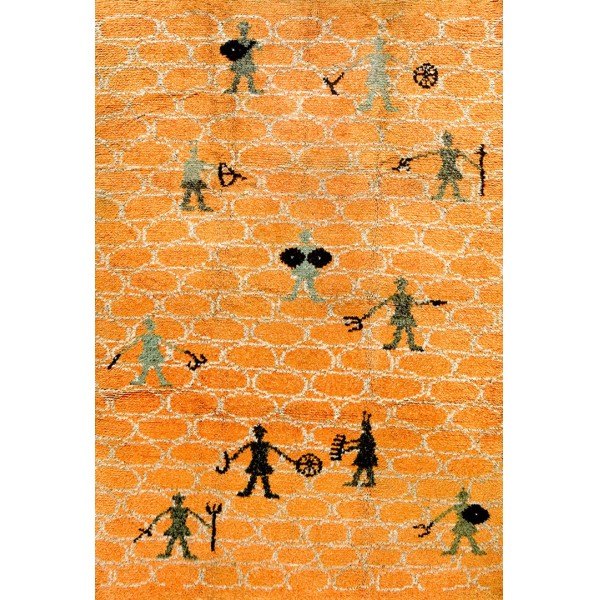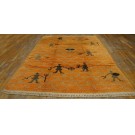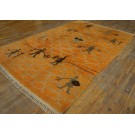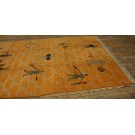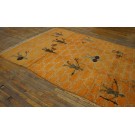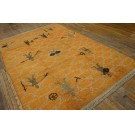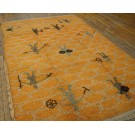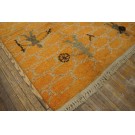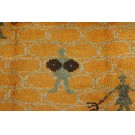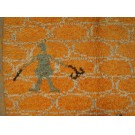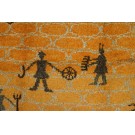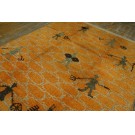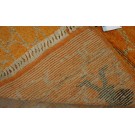Mid 20th Century Rya Carpet
Rya Small Carpet
European, Sweden
Middle 20th century, C. 1950
Wool pile of symmetric knots on ecru cotton
The pictorial tradition in Scandinavian Rya and Rollakan pile and flat-weave, rugs and carpets is more than two centuries old, and in fact probably had an origin back in Mediaeval times. The rugs were originally intended for coaches and later developed as cushion covers and larger floor pieces.
The study of Swedish 20th century carpets has not been the subject of a detailed monograph and there is still much to learn. The gap between Marta Mas and Barbro Nilsson on one hand, and more rustic, as here, productions has not yet been elucidated.
The relatively shaggy pile is arranged in an oval ecru lattice creating pumpkin yellow – orange reserves, forming a background for stick figures of peasants wielding pitchforks, baskets, staves and slings for seeding. Some could be construed as ancient military figures with shields. There are no borders and the figures seem to randomly come and go, without an underlying story or epic. Although the wheel has mythological Scandinavian references, the wheel floating near the top of the carpet is just a wheel, no epic reference intended. Cotton foundations, with their superior shape retention and general floor worthiness, supplanted wool on larger Scandinavian carpets by the mid-20th century. Larger, clearly workshop creations embodying Art Deco designs, were already made wool on cotton by the 1930’s. The type of foundation material does not affect the authenticity of the work, however.
European, Sweden
Middle 20th century, C. 1950
Wool pile of symmetric knots on ecru cotton
The pictorial tradition in Scandinavian Rya and Rollakan pile and flat-weave, rugs and carpets is more than two centuries old, and in fact probably had an origin back in Mediaeval times. The rugs were originally intended for coaches and later developed as cushion covers and larger floor pieces.
The study of Swedish 20th century carpets has not been the subject of a detailed monograph and there is still much to learn. The gap between Marta Mas and Barbro Nilsson on one hand, and more rustic, as here, productions has not yet been elucidated.
The relatively shaggy pile is arranged in an oval ecru lattice creating pumpkin yellow – orange reserves, forming a background for stick figures of peasants wielding pitchforks, baskets, staves and slings for seeding. Some could be construed as ancient military figures with shields. There are no borders and the figures seem to randomly come and go, without an underlying story or epic. Although the wheel has mythological Scandinavian references, the wheel floating near the top of the carpet is just a wheel, no epic reference intended. Cotton foundations, with their superior shape retention and general floor worthiness, supplanted wool on larger Scandinavian carpets by the mid-20th century. Larger, clearly workshop creations embodying Art Deco designs, were already made wool on cotton by the 1930’s. The type of foundation material does not affect the authenticity of the work, however.
| Stock ID: | #19728 |
| General Rug Type: | European |
| Specific Rug Type: | Rya |
| Circa: | 1950 |
| Ground Color: | Pumpkin |
| Border Color: | Pumpkin |
| Origin: | Sweden |
| Material: | Wool |
| Weave: | Pile - Knotted |
| Shape: | Rectangle |
| Width: | 6' 6" ( 198 cm ) |
| Length: | 9' 9" ( 297 cm ) |
| Tearsheet Download |
